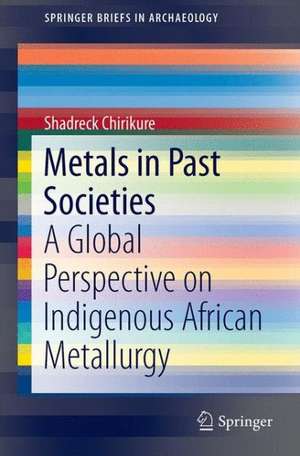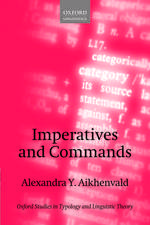Metals in Past Societies: A Global Perspective on Indigenous African Metallurgy: SpringerBriefs in Archaeology
Autor Shadreck Chirikureen Limba Engleză Paperback – 31 mar 2015
The book focuses on Africa’s different regions as roughly defined by cultural geography. On the one hand there is North Africa, Egypt, the Egyptian Sudan, and the Horn of Africa which share cultural inheritances with the Middle East and on the other is Africa south of the Sahara and the Sudan which despite interacting with the former is remarkably different in terms of technological practice. For example, not only is the timing of metallurgy different but so is the infrastructure for working metals and the associated symbolic and sociological factors. The cultural valuation of metals and the social positions of metal workers were different too although there is evidence of some values transfer and multi-directional technological cross borrowing. The multitude of permutations associated with metals production and use amply demonstrates that metals participated in the production and reproduction of society.
Despite huge temporal and spatial differences there are so many common factors between African metallurgy and that of other regions of the world. For example, the role of magic and ritual in metal working is almost universal be it in Bolivia, Nepal, Malawi, Timna, Togo or Zimbabwe. Similarly, techniques of mining were constrained by the underlying geology but this should not in any way suggest that Africa’s metallurgy was derivative or that thecontinent had no initiative. Rather it demonstrates that when confronted with similar challenges, humanity in different regions of the world responded to identical challenges in predictable ways mediated as mediated by the prevailing cultural context.
The success of the use of historical and ethnographic data in understanding variation and improvisation in African metallurgical practices flags the potential utility of these sources in Asia, Latin America and Europe. Some nuance is however needed because it is simply naïve to assume that everything depicted in the history or ethnography has a parallel in the past and vice versa. Rather, the confluence of archaeology, history and ethnography becomes a pedestal for dialogue between different sources, subjects and ideas that is important for broadening our knowledge of global categories of metallurgical practice.
Din seria SpringerBriefs in Archaeology
-
 Preț: 447.84 lei
Preț: 447.84 lei -
 Preț: 382.95 lei
Preț: 382.95 lei -
 Preț: 381.00 lei
Preț: 381.00 lei -
 Preț: 386.22 lei
Preț: 386.22 lei -
 Preț: 379.68 lei
Preț: 379.68 lei -
 Preț: 381.00 lei
Preț: 381.00 lei -
 Preț: 378.71 lei
Preț: 378.71 lei -
 Preț: 381.81 lei
Preț: 381.81 lei - 15%
 Preț: 470.24 lei
Preț: 470.24 lei -
 Preț: 411.32 lei
Preț: 411.32 lei -
 Preț: 381.21 lei
Preț: 381.21 lei -
 Preț: 382.95 lei
Preț: 382.95 lei -
 Preț: 377.35 lei
Preț: 377.35 lei -
 Preț: 448.28 lei
Preț: 448.28 lei -
 Preț: 380.84 lei
Preț: 380.84 lei -
 Preț: 377.18 lei
Preț: 377.18 lei -
 Preț: 379.86 lei
Preț: 379.86 lei -
 Preț: 445.33 lei
Preț: 445.33 lei -
 Preț: 413.45 lei
Preț: 413.45 lei -
 Preț: 406.79 lei
Preț: 406.79 lei -
 Preț: 412.13 lei
Preț: 412.13 lei -
 Preț: 420.68 lei
Preț: 420.68 lei -
 Preț: 457.35 lei
Preț: 457.35 lei - 20%
 Preț: 386.76 lei
Preț: 386.76 lei -
 Preț: 316.95 lei
Preț: 316.95 lei -
 Preț: 281.65 lei
Preț: 281.65 lei -
 Preț: 349.47 lei
Preț: 349.47 lei -
 Preț: 377.18 lei
Preț: 377.18 lei -
 Preț: 381.98 lei
Preț: 381.98 lei -
 Preț: 487.37 lei
Preț: 487.37 lei -
 Preț: 381.00 lei
Preț: 381.00 lei -
 Preț: 381.00 lei
Preț: 381.00 lei
Preț: 448.38 lei
Nou
Puncte Express: 673
Preț estimativ în valută:
85.79€ • 89.59$ • 70.85£
85.79€ • 89.59$ • 70.85£
Carte tipărită la comandă
Livrare economică 15-29 aprilie
Preluare comenzi: 021 569.72.76
Specificații
ISBN-13: 9783319116402
ISBN-10: 3319116401
Pagini: 166
Ilustrații: XXI, 166 p. 65 illus., 44 illus. in color.
Dimensiuni: 155 x 235 x 12 mm
Greutate: 0.27 kg
Ediția:2015
Editura: Springer International Publishing
Colecția Springer
Seriile SpringerBriefs in Archaeology, Contributions from Africa
Locul publicării:Cham, Switzerland
ISBN-10: 3319116401
Pagini: 166
Ilustrații: XXI, 166 p. 65 illus., 44 illus. in color.
Dimensiuni: 155 x 235 x 12 mm
Greutate: 0.27 kg
Ediția:2015
Editura: Springer International Publishing
Colecția Springer
Seriile SpringerBriefs in Archaeology, Contributions from Africa
Locul publicării:Cham, Switzerland
Public țintă
ResearchCuprins
Chapter 1: Metals and the production and reproduction of society.- Chapter 2: Origins and development of Africa’s pre-industrial mining and metallurgy.- Chapter 3: Mother earth provides: mining and crossing the boundary between nature and culture.- Chapter 4: Domesticating nature.- Chapter 5: Socializing metals.- Chapter 6: The social role of metals.- Chapter 7: Bridging conceptual boundaries, a global perspective.
Recenzii
“This compact but comprehensive book on African metallurgy is the first of a Springer series that aims to boost the visibility of African archaeology and emphasise its relevance to broader archaeological debates. … This book seems to be a very positive step towards ensuring that this occurs by eloquently presenting the numerous ways in which African archaeometallurgy has influenced archaeological theory to date and highlighting those arenas upon which it can make an impact in the future.” (Louise Iles, Azania, Archaeological Research in Africa, Vol. 51 (2), 2016)
“This slim book shines a spotlight on pre-industrial African metallurgy, its global connections, and anthropological implications. … The sources of information are adequately cited, and the long list of references at the end of each chapter will be a boon to researchers in thisfield. … This volume is well written and illustrated with photos, micrographs, colorful maps, and drawings that enliven this challenging topic.” (Ram Devanathan, MRS Bulletin, Vol. 40, October, 2015)
“This slim book shines a spotlight on pre-industrial African metallurgy, its global connections, and anthropological implications. … The sources of information are adequately cited, and the long list of references at the end of each chapter will be a boon to researchers in thisfield. … This volume is well written and illustrated with photos, micrographs, colorful maps, and drawings that enliven this challenging topic.” (Ram Devanathan, MRS Bulletin, Vol. 40, October, 2015)
Notă biografică
Shadreck Chirikure graduated with a Masters of Arts in Artefact Studies Degree and a PhD in Archaeology from the Institute of Archaeology, University College London. Chirikure was born into one of the most senior houses of the Gutu-Rufura people in rural Zimbabwe. During his childhood years, Chirikure’s grandmother was a potter and a number of men were forging scrap iron in his village. Therefore, negotiating through rituals and taboos embedded in pottery making and other categories of practice were part of Chirikure’s experience growing up. Unknown to him, these would be part of his academic routine when he later became an archaeologist. Because of this village experience, Chirikure always attempts to gestate archaeological reconstructions that are tempered with local realities where nothing was fixed in space and time. His main research marries techniques from earth and engineering sciences with those from more humanistic disciplines to study high temperature technologiessuch as metallurgy and pottery making to enlighten their contribution to societal development. Currently, Chirikure’s work on the metallurgy of the World Heritage Sites of Great Zimbabwe and Khami in southern Africa is throwing new light on the contribution of metals to culture contact, interaction, and social differentiation. The work shows that metals, like cattle were a pivot on which society achieved growth and renewal. Shadreck has published extensively on the subject including a book, multiple journal articles, book chapters and contributions prestigious encyclopaedias. In the process, he won several national and international awards for his contributions to African Iron Age research.
Caracteristici
Communicates the key attributes of African metallurgy, to both a global and local audience Provides narrative on conceptual gaps between the technological and sociological dimensions of metallurgy Considers the five metals of Sub-Saharan African civilizations, and how their working varied from area to area within the wider archaeology of the continent Includes supplementary material: sn.pub/extras














